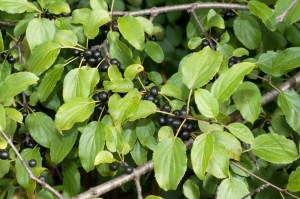Tall understory shrub or small tree, 20-25’. Commonly grow in shrub form with many stems sprouting from the same base. Leaf scars are prominent in winter. Cut branch exposes yellow sapwood and orange heartwood. Common buckthorn has brown to silvery bark that is somewhat shiny when young and dark grey to black and scaly when mature. Buds are found in pairs at end of branches, are covered in dark scales, and resemble a hoof. Twigs often end in stout thorns.
Legal classification in WI: Restricted, including all cultivars except ‘Asplenifolia’ and ‘Fineline’ (Ron Williams).
Leaves: Ovate or elliptical, with prominent veins curving toward tip. Stay green late into fall. Mostly opposite leaves, 1–2.5” long, with tiny teeth.
Flowers: Small and clustered where the leaf attaches to the stem (leaf axil). Common buckthorn has fragrant, greenish-yellow, four-petaled flowers that bloom from late spring.
Fruits and seeds: Abundant clusters of round, 0.25” diameter fruit. Common buckthorn is dioecious and female trees have black fruit.
Roots: Extensive fibrous root system extending from a woody crown.
Similar species: Alder buckthorn (R. alnifolia; native) is < 3’ tall with thornless twigs. Lance-leafed buckthorn (R. lanceolata; native) is less than 6’ tall, found in wet areas and on dry limestone slopes, and has alternate leaves, 2–6” long, gradually tapering to a point at the tip. Carolina buckthorn (R. caroliniana; native), found in the southern Midwest, is 10–30’ tall with toothed, mostly alternate leaves, 2–3” long.
Ecological threat:
• Common buckthorn invades the understory of southern oak, oak-beech, maple, and riparian woods. It also invades prairies, savannas, hedgerows, pastures, old fields, roadsides, and rocky sites.
• Buckthorns are characterized by prolific reproduction by seed, long-distance dispersal ability, wide habitat tolerance, and high levels of phenotypic plasticity (adjusting physical appearance to maximize productivity across environmental conditions).
• Leaf out very early and retain leaves late into the growing season, providing a longer growing season than native plants.
For more information visit: http://dnr.wi.gov/topic/Invasives/fact/CommonBuckthorn.html
(Photo source http://www.florafinder.com)

